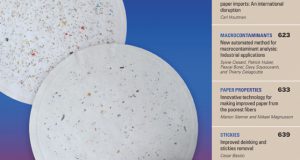Inside
The papers summarized here are from the August 2017 issue of TAPPI Journal. TAPPI Journal is an online publication of relevant and timely peer-reviewed research delivered via email and free to all TAPPI members. To receive TAPPI Journal, join TAPPI at www.tappi.org.
TISSUE
Visual discrimination of hygiene tissue softness in the absence of haptic feedback
Jessica Carette, Pierre-Majorique Léger, and Sylvain Sénécal
 Our perception of the softness of materials is dominated by the subjective interpretation of haptic stimuli—touch. Although softness is defined by the way a material deforms when force is applied, other sensorial inputs, such as vision and hearing, can be used to complement haptic feedback or when the material cannot be touched.
Our perception of the softness of materials is dominated by the subjective interpretation of haptic stimuli—touch. Although softness is defined by the way a material deforms when force is applied, other sensorial inputs, such as vision and hearing, can be used to complement haptic feedback or when the material cannot be touched.
Surface and bulk softness elements of hygiene tissue can be assessed visually. Softness is reported as the number one desired quality of hygiene tissue. So, it is of paramount importance to understand the criteria a consumer uses to judge softness visually. Consumers must rely on these other non-tactile senses at point-of-purchase or in e-commerce because they cannot interact with a product to judge the softness.
This study proposes that a consumer can accurately gauge softness by sight alone, and that factors such as color tone, embossing, and image quality all affect the perception of softness. Stiffness and mechanical properties of the sheet cannot be observed by eye and can contribute to errors in visual judgment.
 The researchers conducted an experiment using a complete pair ratio (round-robin) type comparison to evaluate the perceived softness of altered images of hygiene tissue with unaltered images. Images of hygiene tissue were altered to represent different lighting conditions or product color and digital image degradation. Our results suggest that yellow hygiene tissue is perceived as less soft than blue, and un-embossed tissue as less soft than embossed tissue. Reducing the image resolution to 10 percent of the original did not negatively affect the perception of softness.
The researchers conducted an experiment using a complete pair ratio (round-robin) type comparison to evaluate the perceived softness of altered images of hygiene tissue with unaltered images. Images of hygiene tissue were altered to represent different lighting conditions or product color and digital image degradation. Our results suggest that yellow hygiene tissue is perceived as less soft than blue, and un-embossed tissue as less soft than embossed tissue. Reducing the image resolution to 10 percent of the original did not negatively affect the perception of softness.
In product development, color and embossing pattern can be manipulated to influence the consumer’s perception of product softness. Images displayed digitally can be optimized in a similar manner.
BIOENERGY
Operating parameters affecting the thermal performance of biomass boilers
Naz Orang, Honghi Tran, Andy Jones, and F. Donald Mccabe
 Operating data of a bubbling fluidized bed (BFB) boiler and three stoker grate (SG) biomass boilers from different pulp mills were analyzed over a 2-year period. The results show that in all cases, the thermal performance decreases markedly from 5.5 to 4 lb steam/lb dry biomass as the feedstock moisture content increases from 40 to 60 percent. The BFB boiler had better thermal performance, although it operated in a higher moisture content range compared with the SG boilers.
Operating data of a bubbling fluidized bed (BFB) boiler and three stoker grate (SG) biomass boilers from different pulp mills were analyzed over a 2-year period. The results show that in all cases, the thermal performance decreases markedly from 5.5 to 4 lb steam/lb dry biomass as the feedstock moisture content increases from 40 to 60 percent. The BFB boiler had better thermal performance, although it operated in a higher moisture content range compared with the SG boilers.
Multivariate analysis was also performed on one of the SG boilers to determine operating parameters that affect thermal performance. The results show that furnace temperature, oil flow rate, and induced draft (ID) fan current positively correlate with thermal performance, while the feedstock moisture content, total air flow, and excess oxygen negatively correlate with thermal performance. This implies that when making modifications to improve thermal performance, it is important to consider correlations among various parameters. In some cases, one positively correlated parameter might cause an increase in a negatively correlated parameter. The net effect might be a decrease in thermal performance.
This study demonstrates how mills can find the most suitable way to optimize boiler operation with minimal process upsets.
BIOENERGY
Drying characteristics of biosludge from pulp and paper mills
Geanna Hovey, D. Grant Allen, and Honghi Tran
Handling and disposal of biosludge has been a persistent problem for many pulp and paper mills primarily because of the material’s high moisture content and poor dewatering and drying characteristics. Most biosludge is landfilled or incinerated, and some is used as a soil amendment. To incinerate biosludge, mills mix it with primary sludge, mechanically dewater the mixture to 15–30 percent solids, and burn it with hog fuel in biomass boilers. For biosludge to burn effectively, however, it must be dewatered or dried to at least 30–35 percent solids.
 Researchers conducted a systematic study to examine the drying characteristics of biosludge collected from pulp and paper mills at various temperatures using a thermogravimetric dryer. The drying behavior of the tested biosludges was similar, adding fillers such as wood fines and biomass boiler fly ash to biosludge up to 30 wt percent did not significantly affect the drying rate, higher organic content might make biosludge more difficult to dry, and increasing drying temperature significantly increases the drying rate as expected.
Researchers conducted a systematic study to examine the drying characteristics of biosludge collected from pulp and paper mills at various temperatures using a thermogravimetric dryer. The drying behavior of the tested biosludges was similar, adding fillers such as wood fines and biomass boiler fly ash to biosludge up to 30 wt percent did not significantly affect the drying rate, higher organic content might make biosludge more difficult to dry, and increasing drying temperature significantly increases the drying rate as expected.
This research shows that mills can optimize their biosludge handling and disposal practices by understanding the material’s drying characteristics.
PAPERMAKING
Modeling the influence of forming fabric structure on vacuum box dewatering
Björn Sjöstrand, Christophe Barbier, and Lars Nilsson
This investigation used numerical models to describe forming section sheet dewatering at the high vacuum suction boxes. Three different fabric structures were examined with numerical models for single-phase flow of air and for two-phase flow of air and water. This was done to evaluate how forming fabric structure influences sheet dewatering.
The numerical models were compared with an experimental study of the same fabrics investigated on a laboratory suction box. The small differences in dewatering rate in the experimental study could be simulated with the models, which confirmed the validity of the models. This implies that these numerical models can be used to describe new fabrics and how they will respond in the papermaking process.
This investigation shows how numerical models can be used by manufacturers of paper machine clothing to obtain insights into how forming fabrics influence dewatering processes without investments in laboratory equipment and time-consuming experimental work.
Oculometry and heat maps were used to discover how much of the tissue image participants looked at before determining softness.
Thermal performance (TP) response contour for changes in moisture content (MC) and (a) lower furnace temperature, (b) total air flow, (c) ID fan current, and (d) ID fan outlet temperature. The contours show that regardless of y-axis variable, TP decreases with increasing MC.
Addition of solids—fly ash and wood fines—reduces cracking of biosludge samples during drying. More cracking occurs with fly ash because wood fines are more rigid, providing more support for sludge.
 Paper 360
Paper 360


